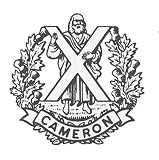Related Research Articles

The Queen's Own Cameron Highlanders or 79th Regiment of Foot was a line infantry regiment of the British Army, raised in 1793. It amalgamated with the Seaforth Highlanders to form the Queen's Own Highlanders in 1961.
The 77th Regiment of Foot was a Highland Scots Regiment raised in 1757. The 77th Regiment was one of the first three Highland Regiments to fight in North America. During the Seven Years' War, the regiment lost 110 soldiers and 259 were wounded.
The 78th Regiment, (Highland) Regiment of Foot also known as the 78th Fraser Highlanders was a British infantry regiment of the line raised in Scotland in 1757, to fight in the Seven Years' War. The 78th Regiment was one of the first three Highland Regiments to fight in North America.

The 42nd Regiment of Foot was a Scottish infantry regiment in the British Army also known as the Black Watch. Originally titled Crawford's Highlanders or the Highland Regiment and numbered 43rd in the line, in 1748, on the disbanding of Oglethorpe's Regiment of Foot, they were renumbered 42nd and in 1751 formally titled the 42nd (Highland) Regiment of Foot. The 42nd Regiment was one of the first three Highland Regiments to fight in North America. In 1881 the regiment was named The Royal Highland Regiment , being officially redesignated The Black Watch in 1931. In 2006 the Black Watch became part of the Royal Regiment of Scotland.
The 91st Regiment of Foot was a Line Regiment of the British Army, raised in 1794. Under the Childers Reforms it amalgamated with the 93rd Regiment of Foot to form the Argyll and Sutherland Highlanders in 1881.
Campbell's Highlanders may refer to one of two Highland regiments in the British Army, both active 1760–1763:
The 100th Regiment of Foot, also known as Campbell's Highlanders, was an infantry regiment of the British Army, formed in 1760 and disbanded in 1763.
The 87th Regiment of Foot was a Scottish infantry regiment in the British Army, formed in 1759 and disbanded in 1763.
Loudon's Highlanders, or the 64th Highlanders, or Earl of Loudon's Regiment of Foot, was an infantry regiment of the British Army.
The 114th Regiment of Foot was an infantry regiment of the British Army from 1761 to 1763.It was raised in October 1761, by Sir Allan MacLean of Torloisk. He was commissioned lieutenant in the 60th Foot Royal Americans at the beginning of the Seven Years' War and was severely wounded at Ticonderoga in 1758. He was then given one of the four NY Independent Companies until he returned to Scotland where he raised the 114th Maclean's Highlanders, or the Royal Highland Volunteers, as their Major Commandant. The regiment was disbanded in 1763.

The feather bonnet is a type of military headdress used mainly by the Scottish Highland infantry regiments of the British Army from about 1763 until the outbreak of World War I. It is now mostly worn by pipers and drummers in various bands throughout the world. It is also worn in a similar fashion by regiments in various Commonwealth armies.
The 101st Regiment of Foot, or Johnston's Highlanders, was an infantry regiment of the British Army, formed in 1760 and disbanded in 1763. The regiment was raised in 1760 by the regimentation of independent companies of infantry raised in Argyll and Ross-shire; in 1761 it was moved into England, and its other ranks drafted to the 87th and 88th Foot.
Four regiments of the British Army have been numbered the 105th Regiment of Foot:
The 71st Regiment of Foot was a regiment of infantry raised in 1775, during the American Revolutionary War and unofficially known as Fraser's Highlanders. It was disbanded in 1786.
The 105th Regiment of Foot was a short-lived British line infantry regiment. It was raised in Perthshire by Major-General David Graeme as a two-battalion regiment on 15 October 1760 by converting independent companies. It was named after Charlotte of Mecklenburg-Strelitz, who had been selected as the wife for the future George III of Great Britain. The regiment served in Ireland and was disbanded in 1763.
Four regiments of the British Army have been numbered the 74th Regiment of Foot:
The plan of raising a fencible corps in the Highlands was first proposed and carried into effect by William Pitt the Elder, in the year 1759. During the three preceding years both the fleets and armies of Great Britain had suffered reverses, and it was thought that a "home guard" was necessary as a bulwark against invasion.
The Independent Highland Companies were irregular militia raised from the Scottish clans of the Scottish Highlands by order of the Government between 1603 and 1760 in order to help keep the peace and enforce the law in the Highlands, and were officially recognized as such by the Government. The officers of the Independent Highland Companies were commissioned as officers of the British Army, but the companies themselves were not recognized as official regiments of the line of the army. The Independent Highland Companies were the progenitors of the world-famous Highland Regiments of the British Army that began when ten Independent Highland Companies were embodied to form the Earl of Crawford's Highland Regiment that was numbered the 43rd Regiment of Foot in 1739.
Events from the year 1763 in Scotland.
The 76th Regiment of Foot , sometimes referred to as 'MacDonnell's Highlanders' after its colonel, John MacDonnell of Lochgarry, was a Scottish Light Infantry regiment raised in the west of Scotland and western isles of Scotland in 1777.
References
- 1 2 3 "88th Regiment of Foot (Campbell's Highlanders)". Regiments.org. Archived from the original on 10 October 2004. Retrieved 6 March 2017.
| | This Scottish history-related article is a stub. You can help Wikipedia by expanding it. |
| This article about a specific British military unit is a stub. You can help Wikipedia by expanding it. |